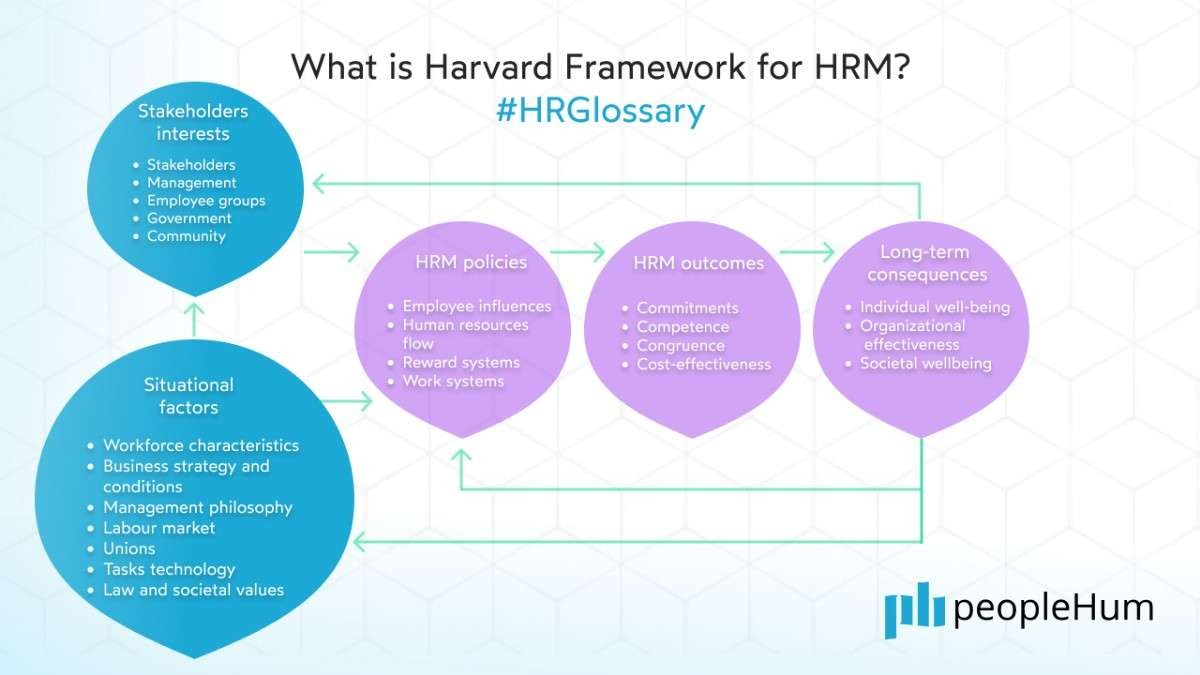
What is the Harvard Framework for HRM?
The Harvard framework for HRM is an HR model that takes a more holistic approach to HR, including different levels of outcome.
One of the most significant assignments that include the staff division in an association is human resources management (HRM). An organization is just prone to accomplish its goals if their representatives are utilized successfully.
Simultaneously, arranging how best to utilize human resources will assist an association with achieving its targets and objectives. Human resources management has vital ramifications. It implies continually searching for better methods for utilizing representatives to profit the association.
The Harvard Model for HRM is one of the most significant HR models. It is based on the work of Paauwe and Richardson (1997) and creates a nuance on the models above in regards to how HR operates.
The Harvard Framework for HRM
The Harvard model for HRM is an HR strategy model comprised of five components:
1. The model starts, on the left, with stakeholder interest. These stakeholders include shareholders, management, employee groups, government, and more. These interests define the model of HRM policies.
2. At the same time, situational factors influence these interests. Situational factors include workforce characteristics, unions, and all the other factors that were also listed in the 8-box model.
3. Situational factors and stakeholder interest influence HRM policies. These include the core HR activities, like recruitment, training, and reward systems.
4. When done well, strategic HRM policies lead to positive HRM outcomes. These includes retention, cost-effectiveness, commitment, and competence.
5. These positive HRM outcomes lead to long-term consequences. These can be individual, organizational, and societal.

Strategic human resource management (SHRM) can be defined as a way of deciding on the plans and intentions of an organisation looking at the relationship between employment and the following human resource management processes and procedures within an organisation – development, recruitment, training, benefit and employee relations plans, performance management, strategies and procedures.
It’s an approach to human resource management that has the goal of using people most wisely with respect to the strategic needs of the organisation. It is strategic way of managing the organisation’s most valued properties: the employees are individually and jointly contributing to the success and achievement of the organisation’s objectives. There are several models and theories of strategic human resource management.
Among these are best practice model and contingency model identified by Hope-Hailey et al (1998). According to Michael Armstrong in his book titled ‘A handbook of Human Resource Management Practice’. Best practice model of strategic human resource management otherwise known as outcome model is a model that emphasise commitment rather than compliance and advocates processes of culture management to achieve cultural control of an organisation. It is universalist approach.
This model explains that all organisations will record achievements in organisations performance provided they identify, gain commitment to and put in place a set of human resource management practice e.g. reward practice. (Guest, 1997) said and I quote, ‘In this model, ‘high commitment’ aspect binds with human capital, because it must have a very good high level of commitment, put in place by the ‘ideal set of practices”.
This means that the best set of human resource practices have to be put in place for the improvement of work output and well-being of human capital, place priority on how human capital can be motivated, and an idea to accomplish the organisation’s goals while contingency model concentrates on the achievement of fit between organisations/businesses and human resource strategies.
It is a situation where definition of organisations aims, policies and strategies, lists of activities, and breaking down of roles of the department of human resource are updated and only if they are similar to the circumstances of the organisation.
It is essentially about the need to achieve fit between what the organisation is and wants to become (its strategy, culture, goals, technology, the people it employs and its external environment) and what the organisation does (how it is structured, and the processes procedures, and practices it puts into effect).
Human resource management entails developing an organisation that caters for all the activities it requires.














































.avif)